Mushrooms
Media

Species Types
Scientific Name
Agaricus campestris
Description
The meadow mushroom has a smooth white to light grayish cap and pinkish brown gills. It's found in lawns and other grassy areas.
Media

Species Types
Scientific Name
Amanita onusta
Description
The onusta amanita has a grayish white cap with grayish brown warts that are often erect, and a long stalk with grayish brown warts. It grows on the ground in mixed woods.
Media
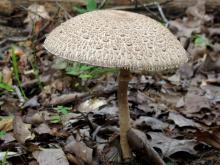
Species Types
Scientific Name
Macrolepiota procera (Lepiota procera)
Description
The parasol is very tall, with a cap that is buff to brown, broad, scaly, with a knob in center; there is a moveable ring on stalk. It grows scattered on the ground, along trails, in open woods, and in old pastures.
Media
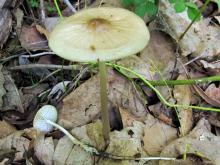
Species Types
Scientific Name
Xerula furfuracea (Collybia radicata var. furfuracea)
Description
The rooted collybia has a moist, wrinkled, grayish brown flat cap and a long, slender stalk that continues underground. It grows singly or scattered on and around deciduous trees and stumps.
Media
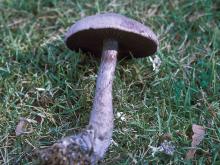
Species Types
Scientific Name
Cortinarius alboviolaceus
Description
The silvery-violet cort has a dry, grayish violet cap, pale violet gills, a club-shaped stalk, and a cobwebby partial veil. It's found in mixed woods, singly or in groups of many.
Media

Species Types
Scientific Name
Pleurotus ostreatus and P. pulmonarius
Description
Oyster mushrooms are choice edibles with broad, fleshy, whitish, grayish, or tan caps and a stubby, off-center stalk. They grow clustered on stumps, logs, and trunks.
Media
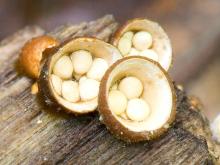
Species Types
Scientific Name
Crucibulum laeve
Description
Splash cups have small brown cups holding tiny “eggs” that are each attached to the “nest” by a cord. They grow in clusters on dead wood, debris, wood chips, and mulch.
Media

Species Types
Scientific Name
Daedaleopsis confragosa (Daedalea confragosa)
Description
The thin-maze flat polypore is a grayish brown bracket fungus with a zoned top and a furrowed, mazelike underside. It grows singly or in small, layered clusters on dead wood or in wounds of living trees.
Media
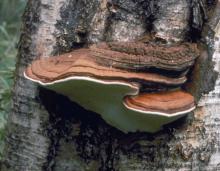
Species Types
Scientific Name
Ganoderma applanatum
Description
The artist conk is a woody, semicircular, brownish bracket with a white underside that bruises dark gray to black. It grows on dead wood or in wounds of living deciduous trees.
Media
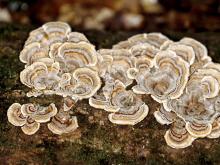
Species Types
Scientific Name
Trametes versicolor
Description
Turkey tail grows in clusters of leathery, thin brackets with multicolored zones above and whitish yellow pores below. Look for it on stumps and logs of deciduous trees.
See Also



Media

Species Types
Scientific Name
Monotropa hypopitys
Description
Pinesap is a plant that puts the "wild" in wildflower! It lacks chlorophyll, so its roots connect to fungi underground and absorb nutrients from the fungi.
Media

Species Types
Scientific Name
Cladophora, Pithophora, and Spirogyra spp., and others
Description
Filamentous green algae forms green, cottony masses that are free-floating or attached to rocks, debris, or other plants.
Media

Species Types
Scientific Name
Monotropa uniflora
Description
Indian pipe lacks chlorophyll, so it is white, not green. Below ground, its roots join with fungi that connect to tree roots. This plant, then, takes nourishment indirectly from the trees.
About Mushrooms in Missouri
Mushrooms are a lot like plants, but they lack chlorophyll and have to take nutrients from other materials. Mushrooms are neither plants nor animals. They are in a different kingdom — the fungi. Fungi include the familiar mushroom-forming species, plus the yeasts, molds, smuts, and rusts.
Always be cautious when eating edible mushrooms. Be absolutely sure of the ID, and only eat a small amount the first time you try it to avoid a reaction..





















